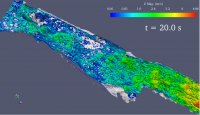CSDMS 2016 annual meeting poster YunxiangChen: Difference between revisions
No edit summary |
No edit summary |
||
| Line 10: | Line 10: | ||
Understanding the hydraulics of subglacial conduits is important for accurately estimating the conduit evolution and changing speed of glaciers. Among those hydraulics problems, parameterizing the surface roughness, sinuosity, and cross-sectional contraction and expansion, and relating those parameters to the development of turbulent boundary layer and hydraulic roughness height are especially crucial. This paper introduces the parametrized surface features of a realistic subglacial conduit under the Arctic, and the preliminary results obtained from large-eddy simulation based on the real conduit geometry. The surface data shows that the small-scale roughness relates larger scale roughness by a scaling law, and can be uniquely determined by horizontal length scales ($l_x$ and $l_y$) and vertical roughness scales ($\sigma_{zx}$ and $\sigma_{zy}$). The sinuosity and cross-sectional variations along the streamwise direction are also calculated based on a self-developed Matlab code. The simulation data shows that there exists a thick boundary layer near the wall, but the influences of the surface parameters on the layer thickness and in-layer velocity is still under studying. | Understanding the hydraulics of subglacial conduits is important for accurately estimating the conduit evolution and changing speed of glaciers. Among those hydraulics problems, parameterizing the surface roughness, sinuosity, and cross-sectional contraction and expansion, and relating those parameters to the development of turbulent boundary layer and hydraulic roughness height are especially crucial. This paper introduces the parametrized surface features of a realistic subglacial conduit under the Arctic, and the preliminary results obtained from large-eddy simulation based on the real conduit geometry. The surface data shows that the small-scale roughness relates larger scale roughness by a scaling law, and can be uniquely determined by horizontal length scales ($l_x$ and $l_y$) and vertical roughness scales ($\sigma_{zx}$ and $\sigma_{zy}$). The sinuosity and cross-sectional variations along the streamwise direction are also calculated based on a self-developed Matlab code. The simulation data shows that there exists a thick boundary layer near the wall, but the influences of the surface parameters on the layer thickness and in-layer velocity is still under studying. | ||
[[image:BottomLambda2Global.png|200px | [[image:BottomLambda2Global.png|200px]]<br>The near wall flow structures of a realistic subglacial conduit in Arctic at t = 20s. | ||
<font color="red">*</font><small> ''Please acknowledge the original contributors when you are using this material. If there are any copyright issues, please let us know and we will respond as soon as possible.''</small> | <font color="red">*</font><small> ''Please acknowledge the original contributors when you are using this material. If there are any copyright issues, please let us know and we will respond as soon as possible.''</small> | ||
</div> | </div> | ||
Latest revision as of 14:37, 1 June 2016
Computational modeling of the hydraulics of a realistic subglacial conduit in Arctic
Xiaofeng Liu, Pennsylvania State University State College Pennsylvania, United States. xliu@engr.psu.edu
Kenneth Mankoff, Pennsylvania State University State College Pennsylvania, United States. mankoff@psu.edu
Abstract:
Understanding the hydraulics of subglacial conduits is important for accurately estimating the conduit evolution and changing speed of glaciers. Among those hydraulics problems, parameterizing the surface roughness, sinuosity, and cross-sectional contraction and expansion, and relating those parameters to the development of turbulent boundary layer and hydraulic roughness height are especially crucial. This paper introduces the parametrized surface features of a realistic subglacial conduit under the Arctic, and the preliminary results obtained from large-eddy simulation based on the real conduit geometry. The surface data shows that the small-scale roughness relates larger scale roughness by a scaling law, and can be uniquely determined by horizontal length scales ($l_x$ and $l_y$) and vertical roughness scales ($\sigma_{zx}$ and $\sigma_{zy}$). The sinuosity and cross-sectional variations along the streamwise direction are also calculated based on a self-developed Matlab code. The simulation data shows that there exists a thick boundary layer near the wall, but the influences of the surface parameters on the layer thickness and in-layer velocity is still under studying.

The near wall flow structures of a realistic subglacial conduit in Arctic at t = 20s.
* Please acknowledge the original contributors when you are using this material. If there are any copyright issues, please let us know and we will respond as soon as possible.

